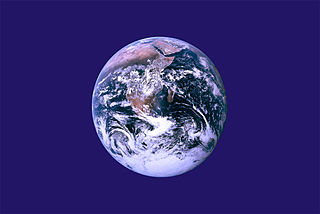
Earth Day is an annual event on April 22 to demonstrate support for environmental protection. First held on April 22, 1970, it now includes a wide range of events coordinated globally by EARTHDAY.ORG including 1 billion people in more than 193 countries. The official theme for 2023 is "Invest In Our Planet".
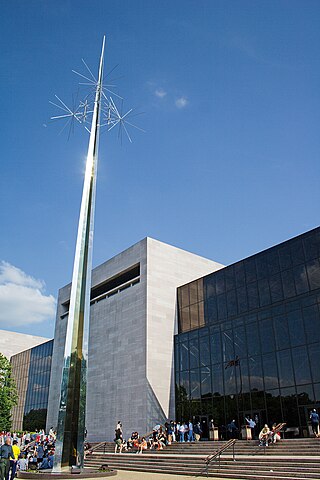
The National Air and Space Museum (NASM) of the Smithsonian Institution, is a museum in Washington, D.C., in the United States dedicated to human flight and space exploration.

Aerial photography is the taking of photographs from an aircraft or other airborne platforms. When taking motion pictures, it is also known as aerial videography.

The Blue Marble is a photograph of Earth taken on December 7, 1972, from a distance of around 29,400 kilometers from the planet's surface. Taken by the crew of the Apollo 17 spacecraft on its way to the Moon, it is one of the most reproduced images in history. The image has the official NASA designation AS17-148-22727.
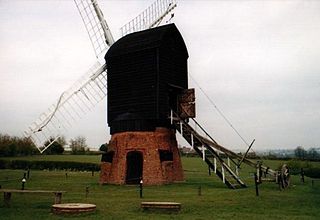
Avoncroft Museum of Historic Buildings is an open-air museum of rescued buildings which have been relocated to its site in Stoke Heath, a district of Bromsgrove, Worcestershire, England. Founded in 1963 and opened in 1967, the museum was conceived following the dismantling of a 15th-century timber-framed house in Bromsgrove in 1962 to provide a location for its reconstruction. It became England's first open-air museum and, after the St Fagans National Museum of History in Wales, the second in the United Kingdom. This building is known as the medieval 'Town House' today, though it has been known by other names in the past, including the 'Bromsgrove House' and the 'Merchant's House'. It now houses a collection of domestic, industrial, agricultural and other forms of historic building, the majority dismantled and re-erected.

Cropmarks or crop marks are a means through which sub-surface archaeological, natural and recent features may be visible from the air or a vantage point on higher ground or a temporary platform. Such marks, along with parch marks, soil marks and frost marks, can reveal buried archaeological sites that are not visible from the ground.

Ana Mendieta was a Cuban-American performance artist, sculptor, painter, and video artist who is best known for her "earth-body" artwork. She is considered one of the most influential Cuban-American artists of the post-World War II era. Born in Havana, Mendieta left for the United States in 1961.
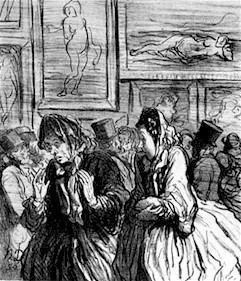
An art exhibition is traditionally the space in which art objects meet an audience. The exhibit is universally understood to be for some temporary period unless, as is occasionally true, it is stated to be a "permanent exhibition". In American English, they may be called "exhibit", "exposition" or "show". In UK English, they are always called "exhibitions" or "shows", and an individual item in the show is an "exhibit".

Spaceship Earth is a dark ride attraction at the Epcot theme park at the Walt Disney World in Bay Lake, Florida. The geodesic sphere in which the attraction is housed has served as the symbolic structure of Epcot since the park opened in 1982 and as such, is often referred to as the "Epcot Ball".

The Massachusetts Museum of Contemporary Art is a museum in a converted Arnold Print Works factory building complex located in North Adams, Massachusetts. It is one of the largest centers for contemporary visual art and performing arts in the United States.
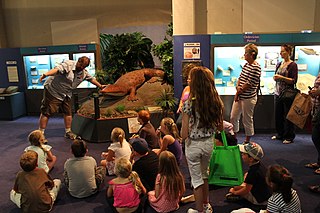
The National Dinosaur Museum is Australia's largest permanent display of prehistoric specimens, located in Canberra, Australian Capital Territory, Australia. It is located in Gold Creek Village, an area within the suburb of Nicholls.

The Norwegian Railway Museum is located at Hamar in Innlandet county, Norway. It is Norway's national railway museum.

The National Archaeological Museum is an archaeological museum in the centre of Sofia, the capital of Bulgaria. It occupies the building of the largest and oldest former Ottoman mosque in the city, originally known as Koca Mahmut Paşa Camii. The construction started in 1451 under grand vizier Veli Mahmud Pasha but due to his death in 1474 the mosque has been completed in 1494. The museum was established as a separate entity in 1893 as the National Museum directed by Czech Václav Dobruský with its headquarters in the former mosque that previously housed the National Library between 1880 and 1893.

Earthrise is a photograph of Earth and part of the Moon's surface that was taken from lunar orbit by astronaut William Anders on December 24, 1968, during the Apollo 8 mission. Nature photographer Galen Rowell described it as "the most influential environmental photograph ever taken".
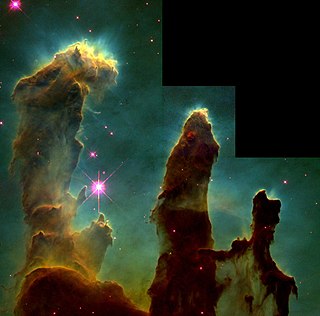
Pillars of Creation is a photograph taken by the Hubble Space Telescope of elephant trunks of interstellar gas and dust in the Eagle Nebula, in the Serpens constellation, some 6,500–7,000 light-years from Earth. These elephant trunks had been discovered by John Charles Duncan in 1920 on a plate made with the Mount Wilson Observatory 60-inch telescope. They are named so because the gas and dust are in the process of creating new stars, while also being eroded by the light from nearby stars that have recently formed.
Robert ParkeHarrison is a photographer, best known for his work in the area of fine art photography.

The Museum of Byzantine Culture is a museum in Thessaloniki, Central Macedonia, Greece, which opened in 1994.

Boeing Galleries are a pair of outdoor exhibition spaces within Millennium Park in the Loop community area of Chicago in Cook County, Illinois, United States. The spaces are located along the south and north mid-level terraces, above and east of Wrigley Square and the Crown Fountain. In a conference at the Chicago Cultural Center, Boeing President and Chief Executive Officer James Bell to Chicago Mayor Richard M. Daley announced Boeing would make a $5 million grant to fund both the construction of and an endowment for the space.

Documerica was a program sponsored by the United States Environmental Protection Agency to "photographically document subjects of environmental concern" in the United States from about 1972 to 1977. The collection, now at the National Archives, contains over 22,000 photographs, more than 15,000 of which are available online. The title is a portmanteau of "documentary" and "America".

Mark Phineas Chamberlain was an American photographer, installation artist, gallery owner, and curator. Born and raised in Dubuque, Iowa, he received his BA in Political Science in 1965, and Master in Operations Research in 1967, from the University of Iowa. Chamberlain was drafted into the U.S. Army in 1967 and stationed in Korea during the American War in Vietnam. On discharge from the army, he changed his previous career course to become a photographic artist. He explained, "While stationed overseas, I picked up a camera to maintain my sanity and provide a creative outlet. I also took classes in Korean language and history and found a photography mentor in the military crafts program. Returning home, I had a growing desire to find an outlet for this newfound passion." In 1969, Chamberlain moved to Southern California, aspiring to open a photographic art gallery.


















